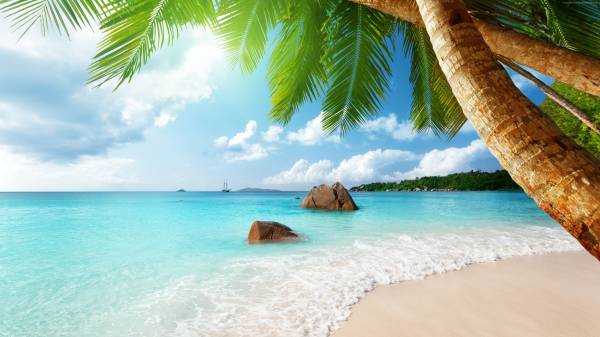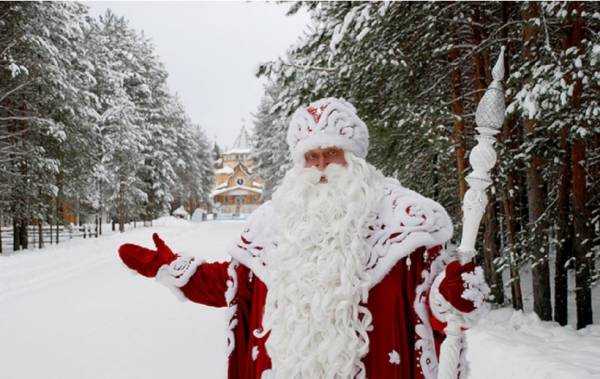My journey through Southeast Asia began in Laos. The starting point was the city of Luang Prabang, the ancient capital of Laos, now the most visited city by foreign tourists in the country. Before the trip, I was afraid of tropical cockroaches and malaria mosquitoes. In Luang Prabang there were neither, but there were many monks, tourists, souvenirs and landscapes, like from detective stories about the colonial world.
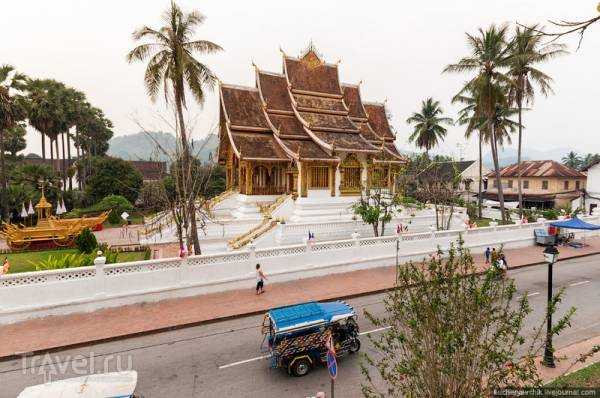
On board the plane from Bangkok, all passengers were wearing seat belts, no one was standing in the aisle, carrying bags of food, smoking or making noise – nothing exotic. Only European tourists were flying in the small modern Airbus. After a long, beautiful landing at sunset over the Mekong River, the plane touched the concrete runway and stopped in front of the neat new building of Luang Prabang airport. The airport was so small that there was an empty space on the boarding pass instead of the name of the city. In Nuremberg, where I checked in for the flight, they didn’t know the name of the city with such a small airport!
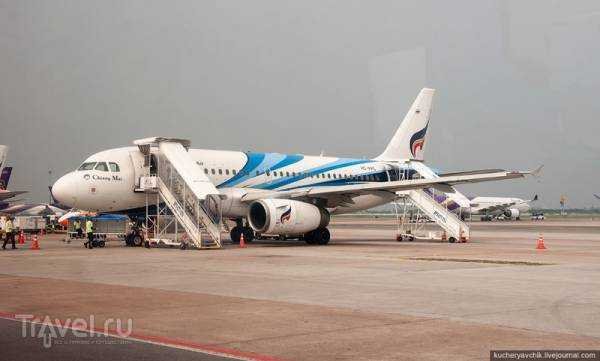
My guidebook said that in Laos it was forbidden to photograph “restricted objects,” which includes airports (there are no train stations or metro in Laos). I looked out the airplane window with apprehension, but did not see a single soldier on the tarmac. The Bangkok Airways flight attendant opened the door and let the passengers out onto the tarmac. We walked to the terminal. Plastic windows, windows made of nasty blue glass – everything looked too right and good for one of the poorest countries in the world. There were no soldiers in sight.

On the airfield, I breathed in the tropical South Asian air for the first time. I had been warned that in April, it would be hard to breathe in Indochina. It is not without reason that April is the least visited month of the year. In June, the rainy season begins, and at the end of April, the air humidity reaches almost 100%, but it does not rain, which makes it very hard to breathe. Your body is covered in sweat within a couple of minutes. After a while, you stop wiping your forehead from sweat - your skin will be constantly damp until I leave Indochina two weeks after arriving in Luang Prabang. Now, as I write this report in November, wrapped in a blanket with a cup of tea, weather.com shows a stable +31 in Luang Prabang. Brrr!

The air conditioning was on inside the terminal. The clean marble floor was so shiny that you could look up the women's skirts! Passengers lined up in two lines: one for visas, the other for those who already had visas. Citizens of many countries, including Ukraine, can get an entry visa at the airport upon arrival. The border guard was polite, but taciturn. The representative of the Laotian authorities reached below my shoulder, but the cabinet he was hiding behind was taller than him. Another police officer was walking along the line. The airport and the presidential palace are the only two places where you can see the military in Laos. In general, there is very little police in Laos. You don't see any on the streets at all. Once I took a photo of a policeman. Later it turned out that he was a volunteer. I saw my first police car in Southeast Asia a week later in Vietnam. In Laos, you could take photos everywhere!

Luang Prabang is the most visited city in Laos, and most tourists start their acquaintance with Laos from here. There were crowds of tuk-tuks and taxis in front of the airport. I jumped into a minibus, where three guys from Europe were already sitting. The driver took us all to hotels. For each hotel, he stopped at the crossroads and asked passers-by where to go. There are no street names in Laos, orientation is based on landmarks and bright characteristics of the house. For example, a blue house towards the river from the temple "wat parawat" will lead you to the goal much faster than "Sihom Road 35" printed in the guidebook. I will tell you an unforgettable story about Sihom Road when I write a report about Vientiane.

As soon as the minibus drove about three hundred meters away from the airport, the asphalt road ended and a standard potholed dusty road began. The driver drove around the potholes, then we didn't cross the bridge over the river and found ourselves in the central part of the city.

The old part of Luang Prabang is located on a cape formed by the confluence of the Nam Khan River and the Mekong. Dozens of ancient monasteries and stupas are located in a limited area. A stupa is a sacred place for Buddhists. There are many temples throughout Laos, but Luang Prabang has the highest density of stupas per square kilometer!
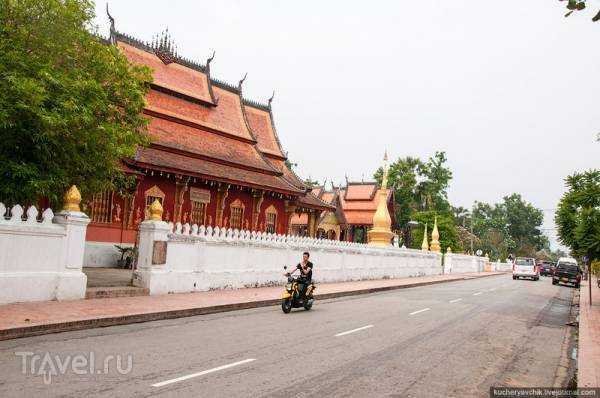
All the monasteries are very similar to each other. Perhaps this has something to do with Buddhism. Architecture in Asia is usually very uniform. The three types of stupas described in my guidebook were so slightly different from each other that an inexperienced tourist would not be able to tell them apart at all. Unlike European architectural heritage, there was no division into Renaissance, Baroque and Art Nouveau in Asia. It is difficult to notice any development in the architecture of Buddhist monasteries from the outside. In this, they are more like Orthodox churches built in the 21st century according to the same unwritten canon as four hundred years ago.

The monasteries are so similar to each other that I had a hard time sorting the photos by location. Each monastery is centered around a main temple and surrounded by a low wall.
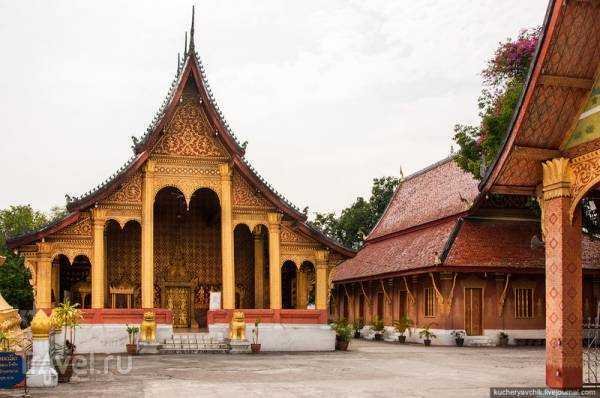
The rectangular temple is crowned with a triangular roof, which rests on columns.

Inside the temple stands a gilded (or simply gold-painted) statue of Buddha. At the feet of the Buddha there are often smaller Buddhas. Temples are painted in bright colors, often a combination of gold and red, because red is a lucky color according to Buddhist beliefs. In general, religious symbolism and church decoration in Asia is very colorful, with a pronounced tendency toward gilding.



The monastery grounds are dotted with pointed cone-shaped stone structures. They are usually figuratively decorated and often painted gold.


The most pleasant impression of the temples was left by the monks. In Laos, these are usually young guys. Some of them learn foreign languages - French, English, Japanese, and you can start a conversation with them. The monks are very positive and friendly.


In the very center of Luang Prabang rises Mount Phu Si. There is a fee to enter the mountain, because the path to the top goes through the rock monastery Wat Thammothayalan. In one of the small temples, a footprint of Buddha is kept - an imprint in stone one and a half meters in diameter. There is also a cave here, inside which you can pray to Buddha, as well as many gilded statues of Buddhas, exhibited in a variety of funny poses. The Tuesday Buddha, for example, is lying on the couch!

At the very top of Phu Si is another pointed Buddhist temple, a rusty cannon from the Vietnam War, and a small observation deck.

The landscape around Luang Prabang was exactly what I had imagined a city in the jungle to be. Karst mountains shape the landscape. The horizon is covered with small houses with sloping roofs among thickets of palm trees. To the west, the city faces the Mekong River, with elongated boats floating along the river. It reminds me of a newsreel from the Vietnam War.

By the way, Laos also suffered during the Vietnam War. Some of the ammunition for communist guerrillas was delivered to southern Vietnam through the Laotian jungle, and the American military command decided to bomb Laos. In some, especially northern, regions of the country, people hid from the bombings in caves and sometimes even lived in them for years. A criminal story that is still hushed up in the West.

I also observed an interesting Laotian custom at the top of the mountain. An old woman was selling birds in a cage on the stairs. The cages were made of some kind of strong exotic stem. So strong that the birds, squeezed between the bars, quickly lost strength trying to escape from the narrow space of the cage, especially in the tropical midday. Adults and children bought the birds, went to the cliff and opened the bottom of the cage. According to legend, the bird was supposed to fly out to freedom, but instead, a dead body often fell out of the cage and rolled into the bushes. The boy sitting next to the old woman-seller jumped up and ran down into the bushes, from where a minute later he brought the abandoned bird and pushed the little body back into the cage.

The photographs show that a thick haze hung over the city the entire time. The mixture of heat and very high humidity causes the moist air to rise from early morning. But since the rainy season has not yet arrived, the moisture does not fall to the ground and continues to hang in the air, settling on the skin as an unpleasant sticky layer.

In the past, the population of Luang Prabang consisted almost exclusively of monks. Dressed in orange robes, the monks led their Buddhist way of life. Buddhism forbids monks from owning worldly goods, so the monks' survival depends on alms from parishioners. Every morning, the monks walk in a slow procession through the streets of Luang Prabang and collect rice, which the townspeople hand over to them at dawn. Tourists willingly participate in the ancient ceremony. The guidebook asks not to turn the religious ceremony into a "photo with a monkey" and to refrain from taking photos.

The center of Luang Prabang is divided into squares. Each square includes several streets around one monastery. Locals navigate by the names of the monasteries. Surprisingly, the post office works in this chaos! My postcard reached the addressee in Ukraine in just three weeks!

In the past, Luang Prabang was the capital of the Lao kingdom until the 17th century. Over the centuries, the city was fought over by the Thais, Khmers, and French. In the Middle Ages, Luang Prabang was the capital of the Kingdom of a Million Elephants, a state in Indochina that is largely the same size as modern Laos. Until the last day of the monarchy, the royal residence was in Luang Prabang, and the city was called the royal capital of Laos. The history of the Lao kingdom ended with the victory of the communists in Laos in 1975.

Since ancient times, Luang Prabang has been the spiritual center of the region. There were dozens of monasteries here, and the monastic way of life largely determined the life of the city. The importance of these numerous ancient monasteries prompted UNESCO to take the entire central part of the city under protection. Since Luang Prabang entered the prestigious list of world cultural heritage, the city has changed greatly. Many ancient monasteries have been reconstructed, the streets have been paved, sidewalks have appeared along the main roads - a completely unusual architectural form for Laos. Old-fashioned lanterns and decorative fences have been installed along the tiled sidewalks. Zebra crossings have been painted at the intersections. In a word, Luang Prabang has been renovated in every possible way.

At the same time, a promenade over the Mekong appeared in the city and many restaurants aimed at Europeans opened. Here you can dine with a view of the Mekong. The main thing is not to stick your head out over the fence. The entire mountain, as well as all of Laos, is littered with garbage. Garbage is a real scourge of Laos.


Source: travel.ru







